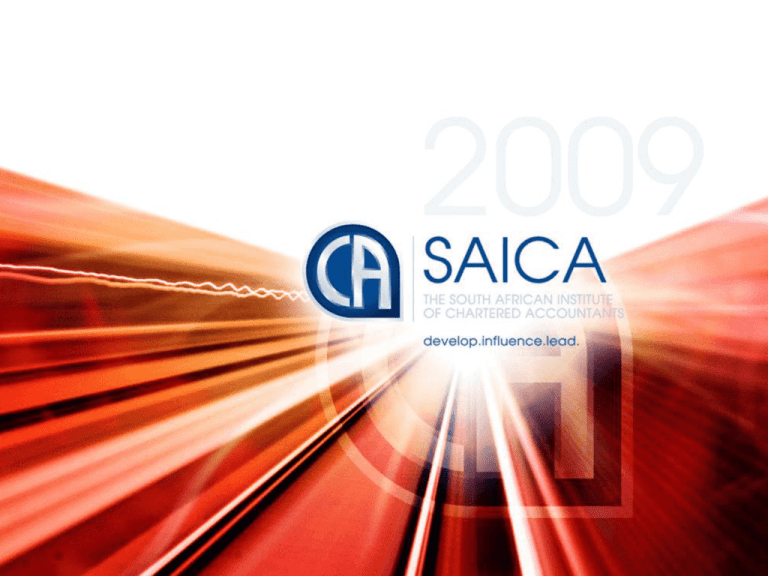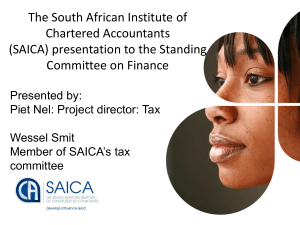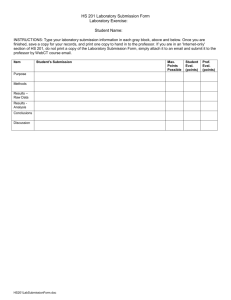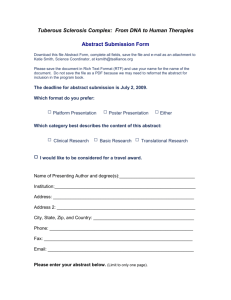SAICA submission – page 30 “par 19 & 20 of the 4 th Schedule”
advertisement

SAICA submission process Process in putting the SAICA submission together: • • • SAICA membership body for Chartered Accountants Comments sourced from NTC members NTC members representation from – big four accounting/auditing firms, legal firms, academia, small & medium practitioners, and commerce & industry Specific comments • • • • • • Provisional tax changes Retirement funds: lump sums Dividend tax issues Controlled foreign companies VAT issues Need for a rebuttal opportunity Provisional tax: SAICA submission – page 30 “par 19 & 20 of the 4th Schedule” Who is affected (provisional taxpayers): All companies, trusts and individuals that receive passive income (interest, dividend, or rental income) in excess of R20 000 per annum. What was the position before the 2008 amendment: Second provisional payment: “basic amount” or may use an amount less than the “basic amount” but if this sum is less than 90% of taxable income as finally assessed, penalty of 20%. “Basic amount”: taxable income reflected in the most recent assessment from SARS. If estimate is greater than the “basic amount”, may use the “basic amount” without incurring any penalties – safe harbour. Provisional tax: SAICA submission – page 30 “par 19 & 20 of the 4th Schedule” What is the position post the 2008 amendment: RLAA 2008 removed the “basic amount” Paragraph 20: should the second provisional tax paid fall short of 80% of the amount as finally assessed, the taxpayer will be subject to 20% additional tax on such shortfall. SAICA: 3 written submissions and held a number of meetings with SARS SARS transitional arrangement Provisional tax: SAICA submission – page 30 “par 19 & 20 of the 4th Schedule” • Issue 1.Automatic penalty for missing a target that is uncertain (reliant on future uncertainties) – certain data only becomes available post year-end 2.Additional workload / system strain / costs associated 3.February year-end pressure Provisional tax: SAICA submission – page 30 “par 19 & 20 of the 4th Schedule” • Solution Primary: Retention of the “basic amount” address problems associated with the “basic amount”. SARS previous practice. Legislate for automatic escalation i.e. inflation adjustment for each year where return remains un-assessed. Alternative: Replace penalty with interest charge instead. International comparison supports this option. Provisional tax: SAICA submission – page 30 “par 19 & 20 of the 4th Schedule” 2009 amendment: Par 19: Commissioner may now by notice Gazette prescribe the basis on which an estimate of taxable income in respect of a designated class of taxpayer must be made. Par 20: Where the taxpayer followed the prescribed basis which must take into account loss to the state the Commissioner must remit additional taxes. Provisional tax: SAICA submission – page 30 “par 19 & 20 of the 4th Schedule” Problem statements / proposed solutions: • Provision is extremely wide • “Designated class of taxpayer” is not defined – must be defined / our proposal to distinguish at LBC • SARS can change the basis on which an estimate is to be determined - issue with communication – what is the basis / has to be “basic amount” • Effective date? Must be 1 March 2009 • Par 20: where the taxpayer followed the prescribed basis must take account any “loss to the state” – clarification Provisional tax: SAICA submission – page 30 “par 19 & 20 of the 4th Schedule” No relief for larger entities • Data only available post year end • Audit adjustments • Stock count adjustments / debtors/ creditors • Actuarial adjustments (insurance industry) Proposed solution • Retention of the “basic amount” • Replace penalty with interest charge instead No change: encourage entities to overpay SARS argument: Par 20 allows SARS to waive the penalty in certain instances – administration RETIREMENT FUNDS: LUMP SUM BENEFITS – 2ND SCHEDULE SAICA submission – page 1 • Current economic climate taxpayers lose their employment. • Forced to take their retirement lump sum “savings” in cash • Due to the cumulative nature of the tables and the fact that the R300 000 “exclusion” now forms part of the retirement table the COMBINED withdrawal and retirement tax are more than an only retirement situation. • “Old legislation” – taxpayers did not lose R120 000 retirement exemption if they withdrew benefits. RETIREMENT FUNDS: LUMP SUM BENEFITS – 2ND SCHEDULE WITHDRAWAL LUMP SUM BENEFITS: RETIREMENT FUNDS: LUMP SUM BENEFITS – 2ND SCHEDULE RETIREMENT LUMP SUM BENEFITS: RETIREMENT FUNDS: LUMP SUM BENEFITS – 2ND SCHEDULE - EXAMPLE The problem is best illustrated by way of an example: • Taxpayer receives R600 000 pre-retirement withdrawal benefits and paid tax according to Table XII on the R600 000 of R103 950. If the same taxpayer then receives an additional lump sum of R100 000 upon retirement the taxpayer will pay tax of R27 000 on the R100 000 by way of application of Table XIII. • Therefore on the R700 000 received in total the taxpayer paid total tax of R130 950. If the person would have retired and received R700 000 the tax would only have been R81 000. This is mainly due to the first R300 000 not being taxable on retirement. RETIREMENT FUNDS: LUMP SUM BENEFITS – 2ND SCHEDULE PROPOSAL: • Retain R300 000 exemption upon retirement – should not be influenced by previous lump sum withdrawal benefits received! DIVIDEND TAX: CAPITALISATION ISSUE OF SHARES – Section 64R SAICA submission – page 11 &12 • Capitalisation issue – subject to dividend tax if it results % increase in shareholding • Problem: Most capitalisation issues have an “cash option” • Even if just one shareholder opts for the cash, then the capitalisation issue will be subject to dividend tax! • Potential cash flow problems for companies • Further, it might discourage foreign investors as they in the past relied on capitalisation issues not being subject to tax (RSA capital importing country)! DIVIDEND TAX: TRANSFER PRICING – Section 64(O)(b) SAICA submission – page 13 • The application of the transfer pricing provisions in S 31(2) results in dividend tax. • This is irrespective of the benefit flowing to a subsidiary or a holding company! • The principle should be that only shareholders (for example holding company) should be subject to this deemed dividend tax provision. • See proposal in illustration on next slide DIVIDEND TAX: TRANSFER PRICING – Section 64(O)(b) Proposal: Holding Company Yes: Dividend tax Company No: not Dividend tax Subsidiary Company CONTROLED FOREIGN COMPANIES (“CFC”): – Section 9D SAICA submission – page 23 • • • • Foreign Business Establishment definition tightened “…is carried on continuous or regular at that location” This does not take worldwide recession into account CFC’s in offshore jurisdictions are struggling for survival – had their operations cut back by SA parent • Trades may reduce substantially – still considered to be continuously? • “Continuous” needs to be defined and element of discretion should be afforded to Commissioner. VAT: Registration process – Sections 1, 6 and 23 of VAT Act SAICA submission – page 33 • Implementation of biometric information required for VAT registrations • Some challenges • Foreign Vendors – not physically in SA – Act should make provision. • For SA vendors – after implementation of biometric information requirements – current stringent requirements should be relaxed – is currently a big obstacle for business. Need for rebuttal opportunity SAICA submission – page 36 “general” 2008 • full day workshop with SARS/ NT post the public hearings by PCoF • ensured written technical comments are understood 2009 • rebuttal opportunity post the release of SARS/ NT response document before SCoF • SCoF or directly with SARS/NT Thank you







